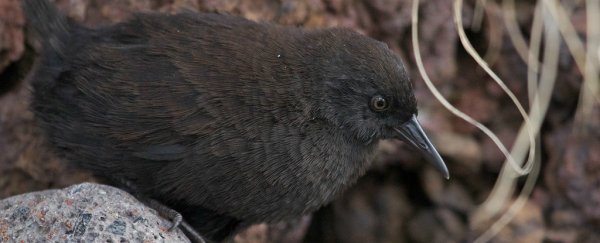It's a mystery that scientists have been trying to solve for nearly a century. How did the world's smallest flightless bird end up on a remote island in the middle of the South Atlantic?
The Inaccessible Island rail (Atlantisia rogersi) is a tiny, flightless bird - 15 to 17 centimetres long - that is only found on Inaccessible Island, making its evolutionary origins difficult to trace.
When scientists first discovered the bird, they thought its ancestors had walked to the remote island, which is nestled between South America and Africa, on stretches of land now swallowed by the sea. So they gave the bird its own genus named Atlantisia.
But unlike Inaccessible Island, that name is a misnomer.
Given how similar this bird looks to the extinct flightless Ascension crake (from another island in the South Atlantic Ocean), researchers took it as a sign that they were related, but a modern analysis of the bird's DNA has shown that is not the case.
The ancestors of the Atlantisia genus once had wings, and they flew to Inaccessible Island 1.5 million years ago.
Today, the bird's closest living relatives are the dot-winged crake in South America and the black rail found in both South and North America. It probably has another relative in the Galapagos, too.
The researchers say this means the birds flew all the way from South America and stopped at one of the first pieces of land they saw, a trip over 3,000 kilometres long (2,000 miles).
"It seems that rail birds are extremely good at colonising new remote locations and adapting to different environments," says evolutionary biologist Martin Stervander, who conducted the research during his time at Lund University.
"Despite great distances, the environments may be similar and, through convergent evolution, distant relatives may in fact become so similar that taxonomists are tricked into drawing erroneous conclusions."
The findings of the study have undermined the original theory, which suggested that the bird's inability to fly was a very old trait and that their ancestors colonised the island on foot.
Instead, it seems that the tiny bird has evolved relatively new traits that allow it to survive and propagate in its remote environment - and these new traits made it look similar to unrelated birds living in comparable environments. Easy mistake, really.
Compared to its ancestors, the Inaccessible Island rail has a longer bill, sturdier legs and a slightly different colour.
It has also lost the ability to fly - a skill that uses up a lot of resources and energy. Now, its wings are just too short to get the animal off the ground.
"The bird has not had any natural enemies on the island and has not needed to fly in order to escape predators," says Martin Stervander.
"Its ability to fly has therefore been reduced and ultimately lost through natural selection and evolution over thousands of years."
But while the island may be remote, that doesn't mean this bird will be safe from predators forever.
Another researcher in the team, Bengt Hansson, says the new findings underline just how rare the bird is, and how important it is to keep the island free of introduced species that could put the Inaccessible Island rail at risk.
"If that happens, it might disappear," warns Hansson.
This study has been published in Molecular Phylogenetics and Evolution.
